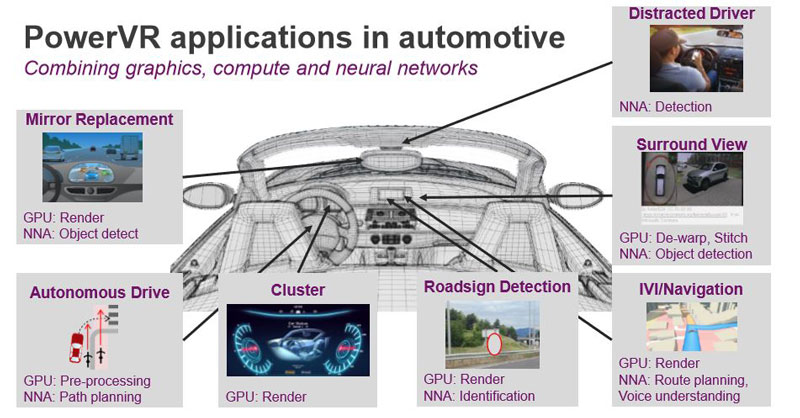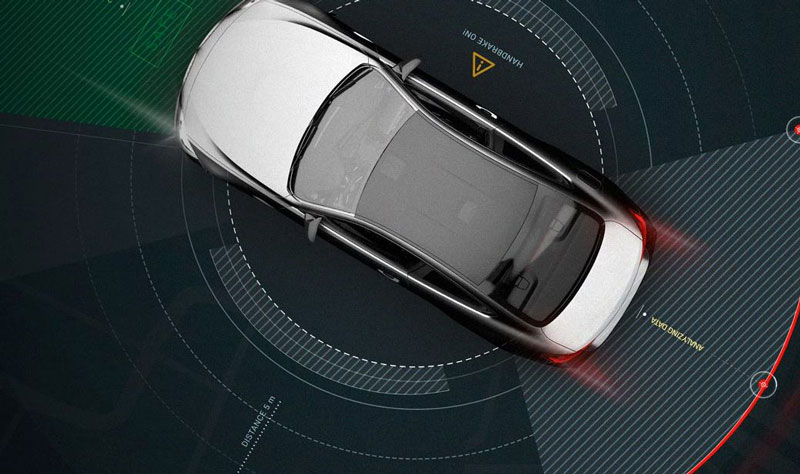A new automotive world order
The landscape of the automotive industry is shifting, and with several disruptive influences, a new automotive world order is upon us. This has been the driving (excuse the pun), force behind Imagination Technologies’ launch of PowerVR Automotive - a complete product package to enable growth and acceleration of the automotive semiconductor industry - combining five essential elements - hardware IP, software, tools, documentation and long term support.
Chris Longstaff, Senior Director of Product and Technology Marketing, said: “It’s an initiative that is all about enabling growth and acceleration of the automotive semiconductor industry, both for our current partners and new entrants. It’s not just about hardware or software, it’s about providing complete solutions for automotive."
Imagination has been involved in automotive IP for over ten years, working with automotive partners, and so the company has been well placed to see that the industry is at a key transition and disruption point as we move from the traditional automotive market, through ADAS and on to autonomous vehicles.
“We thought it was the right time to really shout about our success and underline our commitment to the future of automotive and the investment we and our partners have made in that market.
“PowerVR Automotive is about having the option for our IP to ensure we can deliver the requirements for the automotive market. That’s based on years of experience in terms of supplying that market, but also looking as we are from the point of view of an innovative company that has created a lot of techniques within GPUs and NNAs to enable the transition that’s going. The market disruption that we are seeing today is raising a lot of questions and PowerVR Automotive is about trying to answer these.”

The fact is there’s no one straightforward answer, however. For Imagination it’s about working with its partners and customers to get the right solution for the vast swathe of different automotive applications, each of which will require something a little bit different.
Imagination have built these partnerships over many years and have key partners in terms of semiconductor companies, software vendors, the Tier 1s who are bringing everything together, and then onto the OEMs.
“We have relationships across the board,” said Longstaff, “and that puts us in a unique position to understand the industry and its problems and work across that to answer those difficult questions and help realise those specific applications that our partners are aiming for.
“Certainly there are other companies in the market with those sort of relationships but not that are based around the GPU to support those customers within the automotive market. So I think we are by far and away the best positioned in the market to be a GPU IP supplier to ensure our customers get their products right.”
So what’s changing?
The changing marketplace is really driving Imagination’s roadmap, and is giving the company confidence in the investment it is making in the sector. But what are the key elements of this market disruption?
Electronics and software are increasingly being used as a differentiator which is increasing system complexity and security risks. A new car is released today, whether it’s petrol or electric, and although what’s in the engine is important, the electronics and software can really differentiate between one vehicle and another.
There is a huge appetite for autonomous vehicles. Whether someone wants an autonomous car or not their eventual entrance into the market is unstoppable.
The traditional vehicle OEMs are being challenged by new entrants. These might be car companies, for example there are several car companies in China starting to drive forward with their market share. But also you have entrants who are more traditionally from the electronics side of the industry - the likes of Apple, Baidu, Waymo, Google - who are all trying to enter the market place, so the type of company that Imagination is interacting with is changing.
There is huge growth in emerging economies both in terms of the demand for cars - so places like China and Indonesia have a growing automotive market - but also, the whole industry. So, in low wage economies in Africa for example, Imagination are seeing people working with the training data for the neural networks. So, it is a global industry that is growing not just in terms of the demand for cars, but also in terms of driving all the components forward.
The semiconductor industry itself is growing rapidly. So there are new entrants, particularly in China. Imagination have new licensees coming on board all the time, and a lot of those are in Asia.
The automotive industry is seeing new ownership models. With an autonomous car people will have the option of having a car delivered to a workplace at the end of the day rather than have it sat in the car park all day. You will see robo-taxis and rideshare schemes being used with a previously unseen level of flexibility. And so the whole automotive ownership model will change.
All this means that the pace of innovation in the automotive sector is moving much more in line with industries such as mobile - in other words, much quicker. Imagination are seeing year-on-year growth in terms of performance requirements. Traditional cycles in automotive have been significantly longer and that’s where traditional OEMs need to catch up with some of the tech companies who have been used to a much faster pace of innovation.
And finally, government legislation is impacting significantly on the industry in terms of emissions, safety and congestion.

PowerVR applications
There are a broad range of applications where Imagination’s NNA and GPU can be used within a vehicle of today. The key message is that the GPU is not just used for graphics but also for compute, and the NNA represents a huge spectrum of different applications which are really evolving.
There are of course different quality requirements for each use case for PowerVR. So, the company has split it into three: human informational (traditional infotainment clusters); human reactive (ADAS, lane departure etc); and all the way through to full machine autonomy. These all have very fuzzy boundaries and there is not always a clear distinction between them. What is interesting is how the use case may vary over time.
In terms of the benefits of Imagination’s GPU versus any of the competing GPUs (whether that’s IP or complete systems), Longstaff stressed that the focus is around power. “We have this heritage from our history in mobile and that has given us a power first philosophy, and everything we do we ensure that we are leading in terms of those power characteristics and that the power footprint is minimal. And this is a real USP for Imagination.
“And that’s very important. Autonomous vehicles will feature a huge amount of processing and even with the latest process nodes, you can still quickly become limited in terms of processing, so power efficiency is everything. Every milliwatt counts. If you’re saving a few watts here and there it can make a huge difference.”
PowerVR Series8XT-A
Longstaff stressed that PowerVR is all about enabling the company’s existing and new customers to create disruptive solutions in a changing sector. He added: “Specifically we knew we were launching this new member of the 8XT family and so it made sense to really celebrate the PowerVR initiative with a new product launch.”
That new launch Longstaff mentioned is the new PowerVR Series8XT-A GPU core to complement its existing IP already used extensively in infotainment, digital cockpit and Advanced Driver Assistance Systems (ADAS). PowerVR Series8XT-A has enhanced recovery and reliability features to make it easier for SoC designers to obtain automotive safety certification for their SoCs aimed at digital Human-Machine Interfaces (HMIs) and Autonomous Vehicles (AVs).
Based on the PowerVR Furian architecture, the Series8XT-A is a new member of the Series8XT family of GPUs targeted at cluster, HUD, infotainment and the digital cockpit, as well as ADAS functions.
The Series8XT-A provides Power, Performance and Area (PPA) metrics and enables new features in hardware and software for fault detection and recovery of the GPU. Other new features include Error-Correcting Code (ECC), Logic Built-in Self-test (LBIST), as well as industry-leading verification strategies.
Featuring unique built-in hardware virtualisation, Series8XT-A enables automotive OEMs to keep multiple applications and services running securely in isolated containers, with guaranteed quality of service (QoS) for each.
Neural networks are becoming a fundamental element in the development of automotive - from the occupant’s experience, through to ADAS and autonomous driving.
The PowerVR Series2NX NNA is showcased through ADAS applications such as driver monitoring, driver gaze tracking, seat occupancy, road-sign detection, drivable path analysis, road user detection and driver recognition. Thanks to its performance density for embedded environments, PowerVR’s NNA technology will play a key role in enabling the industry to move from Level 3 to Level 5 autonomous driving.










